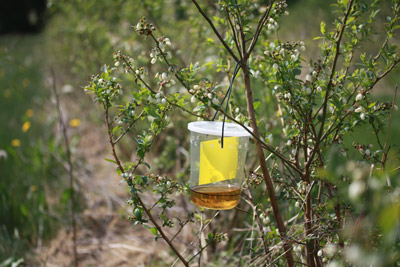Federal grants will fund study of food system, environment
By Kate Frazer

How can farmers battle marmorated stink bugs in vineyards or late blight threatening a tomato crop? Can urban trees help mitigate climate change? What breeding programs will keep American crops competitive? Cornell faculty and extension educators will tackle these and other questions this year with $9 million in Federal Formula Funds from the U.S. Department of Agriculture's National Institute of Food and Agriculture.
The annual grants go to land-grant universities established as a result of the Morrill Land Grant Act. The act founded colleges focused on the practical teaching of agriculture, science and engineering; this year marks the 150th anniversary of President Abraham Lincoln signing it into law.
"These funds were created to help institutions tackle real-world issues," said Michael Hoffmann, associate dean of the College of Agriculture and Life Sciences (CALS) and director of the Cornell University Agricultural Experiment Station (CUAES). "That mission continues today. From developing bioenergy sources to improving nutrition in schools, the challenges we face are wide-ranging, widespread, and must be addressed across disciplines."
Through a competitive process involving a 43-member council of farmers, health and nutrition specialists, business leaders and Cornell experts, these funds are allocated to CALS, Human Ecology and Veterinary Medicine faculty by CUAES, Cornell University Cooperative Extension (CCE) and the New York State Agricultural Experiment Station (NYSAES) in Geneva.
"We review proposals and rate them in a number of categories, including their relevancy to the needs of New York," said Helene Dillard, CALS associate dean and director of CCE.
A few of the 354 projects receiving funding this year are:
"The projects we're funding this year reflect the changing needs of growers and other stakeholders," said Thomas Burr, CALS associate dean and director of NYSAES. "We saw proposals focused on traditional concerns like crop viruses and diseases, and others tackling emerging issues like West Nile virus and the emerald ash borer invasion."
Hoffmann notes a growing interest in climate and energy issues, something he thinks is reflective of people's experiences this year with floods and droughts.
The grants help fill funding gaps that are wider than ever. "With significant reductions in public funding sources, these Federal Formula Funds are a crucial lifeline for research and extension," said Dillard.
Faculty who access this initial support often use it to attract additional funds for more in-depth research. A 2010 study by Cornell that looked at funded projects over 10 years showed that every dollar in formula grant funding allocated to its researchers leveraged an additional $5.62.
Ultimately, the three directors emphasize, the real beneficiaries of this research are growers, food businesses and local communities. "Food and agricultural sectors are major drivers of economic development, and this sector depends on applied research to compete and prosper," said Burr.
"We've got to get creative to find new sources of reliable funding," he added. "But these grants plant essential seeds. They allow scientists to grow solutions to the problems we face in New York state and around the world."
Kate Frazer is the agricultural stations communications officer for the College of Agriculture and Life Sciences.
Media Contact
Get Cornell news delivered right to your inbox.
Subscribe